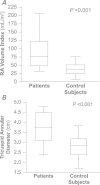Predictors of severe tricuspid regurgitation in patients with permanent pacemaker or automatic implantable cardioverter-defibrillator leads
- PMID: 24391312
- PMCID: PMC3853818
Predictors of severe tricuspid regurgitation in patients with permanent pacemaker or automatic implantable cardioverter-defibrillator leads
Abstract
Patients with permanent pacemaker or automatic implantable cardioverter-defibrillator (AICD) leads have an increased prevalence of tricuspid regurgitation. However, the roles of cardiac rhythm and lead-placement duration in the development of severe tricuspid regurgitation are unclear. We reviewed echocardiographic data on 26 consecutive patients who had severe tricuspid regurgitation after permanent pacemaker or AICD placement; before treatment, they had no organic tricuspid valve disease, pulmonary hypertension, left ventricular dysfunction, or severe tricuspid regurgitation. We compared the results to those of 26 control subjects who had these same devices but no more than mild tricuspid regurgitation. The patients and control subjects were similar in age (mean, 81 ±6 vs 81 ±8 yr; P = 0.83), sex (male, 42% vs 46%; P = 0.78), and left ventricular ejection fraction (0.60 ±0.06 vs 0.58 ± 0.05; P = 0.4). The patients had a higher prevalence of atrial fibrillation (92% vs 65%; P=0.01) and longer median duration of pacemaker or AICD lead placement (49.5 vs 5 mo; P < 0.001). After adjusting for age, sex, and right ventricular systolic pressure by multivariate logistic regression analysis, we found that atrial fibrillation (odds ratio=6.4; P = 0.03) and duration of lead placement (odds ratio=1.5/yr; P = 0.001) were independently associated with severe tricuspid regurgitation. Out study shows that atrial fibrillation and longer durations of lead placement might increase the risk of severe tricuspid regurgitation in patients with permanent pacemakers or AICDs.
Keywords: Atrial fibrillation/complications; cardiac pacing, artificial/adverse effects; defibrillators, implantable/adverse effects; disease progression; echocardiography; electrodes, implanted/adverse effects; pacemaker, artificial/adverse effects; risk factors; tricuspid valve insufficiency/diagnosis/etiology; ventricular dysfunction, right/diagnosis/etiology.
Figures



Similar articles
-
3D echocardiographic location of implantable device leads and mechanism of associated tricuspid regurgitation.JACC Cardiovasc Imaging. 2014 Apr;7(4):337-47. doi: 10.1016/j.jcmg.2013.11.007. Epub 2014 Mar 13. JACC Cardiovasc Imaging. 2014. PMID: 24631508
-
Effects of pacemaker and implantable cardioverter defibrillator electrodes on tricuspid regurgitation and right sided heart functions.Cardiol J. 2015;22(6):637-44. doi: 10.5603/CJ.a2015.0060. Epub 2015 Sep 28. Cardiol J. 2015. PMID: 26412607
-
Worsening tricuspid regurgitation associated with permanent pacemaker and implantable cardioverter-defibrillator implantation: A systematic review and meta-analysis of more than 66,000 subjects.Heart Rhythm. 2023 Nov;20(11):1491-1501. doi: 10.1016/j.hrthm.2023.07.064. Epub 2023 Jul 26. Heart Rhythm. 2023. PMID: 37506990
-
Tricuspid Regurgitation Following Implantation of Endocardial Leads: Incidence and Predictors.Pacing Clin Electrophysiol. 2015 Nov;38(11):1267-74. doi: 10.1111/pace.12701. Epub 2015 Sep 2. Pacing Clin Electrophysiol. 2015. PMID: 26234305
-
Severe tricuspid regurgitation due to interactions with right ventricular permanent pacemaker or defibrillator leads.Pacing Clin Electrophysiol. 2018 Jul;41(7):845-853. doi: 10.1111/pace.13369. Epub 2018 Jun 4. Pacing Clin Electrophysiol. 2018. PMID: 29757467 Review.
Cited by
-
Functional tricuspid valve insufficiency after cardiac transplantation: Which factor is the most important?JTCVS Open. 2020 Aug 3;4:25-32. doi: 10.1016/j.xjon.2020.07.008. eCollection 2020 Dec. JTCVS Open. 2020. PMID: 36004299 Free PMC article.
-
Lead Dependent Tricuspid Valve Dysfunction-Risk Factors, Improvement after Transvenous Lead Extraction and Long-Term Prognosis.J Clin Med. 2021 Dec 24;11(1):89. doi: 10.3390/jcm11010089. J Clin Med. 2021. PMID: 35011829 Free PMC article.
-
Tricuspid insufficiency after cardiac-implantable electronic device placement.J Community Hosp Intern Med Perspect. 2021 Nov 15;11(6):793-798. doi: 10.1080/20009666.2021.1967569. eCollection 2021. J Community Hosp Intern Med Perspect. 2021. PMID: 34804393 Free PMC article.
-
Lead-Specific Features Predisposing to the Development of Tricuspid Regurgitation After Endocardial Lead Implantation.CJC Open. 2019 Oct 31;1(6):316-323. doi: 10.1016/j.cjco.2019.10.002. eCollection 2019 Nov. CJC Open. 2019. PMID: 32159126 Free PMC article.
-
Evolution and prognosis of tricuspid and mitral regurgitation following cardiac implantable electronic devices: a systematic review and meta-analysis.Europace. 2024 Jul 2;26(7):euae143. doi: 10.1093/europace/euae143. Europace. 2024. PMID: 38812433 Free PMC article.
References
-
- Lin G, Nishimura RA, Connolly HM, Dearani JA, Sundt TM 3rd, Hayes DL. Severe symptomatic tricuspid valve regurgitation due to permanent pacemaker or implantable cardioverter-defibrillator leads. J Am Coll Cardiol 2005;45(10):1672–5. - PubMed
-
- Najib MQ, Vinales KL, Vittala SS, Challa S, Lee HR, Chaliki HP. Predictors for the development of severe tricuspid regurgitation with anatomically normal valve in patients with atrial fibrillation. Echocardiography 2012;29(2):140–6. - PubMed
-
- Paniagua D, Aldrich HR, Lieberman EH, Lamas GA, Agatston AS. Increased prevalence of significant tricuspid regurgitation in patients with transvenous pacemaker leads. Am J Cardiol 1998;82(9):1130–2, A9. - PubMed
-
- Klutstein M, Balkin J, Butnaru A, Ilan M, Lahad A, Rosenmann D. Tricuspid incompetence following permanent pacemaker implantation. Pacing Clin Electrophysiol 2009;32 Suppl 1:S135–7. - PubMed
-
- Kim JB, Spevack DM, Tunick PA, Bullinga JR, Kronzon I, Chinitz LA, Reynolds HR. The effect of transvenous pacemaker and implantable cardioverter defibrillator lead placement on tricuspid valve function: an observational study. J Am Soc Echocardiogr 2008;21(3):284–7. - PubMed
MeSH terms
LinkOut - more resources
Full Text Sources
Medical
